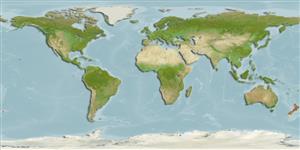分类 / Names
俗名 | 同种异名 | Catalog of Fishes(属, 种) | ITIS | CoL | WoRMS | Cloffa
Teleostei >
Gobiesociformes (Clingfishes) >
Gobiesocidae (Clingfishes and singleslits) > Trachelochisminae
Eponymy: Richard ‘Dick’ Kenneth Dell (1920–2002) was Director, Dominion Museum (now Te Papa). [...] John ‘Jock’ Munne Moreland (1921–2012) was Curator of Fishes, Dominion Museum (now Te Papa), Wellington. [...] (Ref. 128868), visit book page.
More on author: Briggs.
Environment: milieu / climate zone / depth range / distribution range
生态学
海洋 居于水底的; 深度上下限 0 - 15 m (Ref. 9003). 溫帶
Southwest Pacific: endemic to New Zealand.
西南太平洋: 紐西蘭的特有種。
大小 / 重量 / 年龄
Maturity: Lm ? range ? - ? cm
Max length : 8.5 cm TL 雄鱼/尚未辨别雌雄; (Ref. 27207)
简单描述
检索表 | 型态特徵 | 形态测量图
背棘 (总数) : 0; 背的软条 (总数) : 8 - 9; 臀棘: 0; 臀鳍软条: 8 - 9. Head and body purple or cream with blue spots. A band of pale color across nape. Distinguished from other clingfishes by its thin lips, exposed flap of skin across the snout and a small fleshy swelling at the base of the pectoral fin.
Occurs in rock pools and the subtidal zone. Usually found beneath the spines of sea urchins. Individuals too large to be associated with sea urchins usually found beneath rocks or among shell debris. Feeds mainly on the tube feet and pedicellariae of its host sea urchins, Evechinus chloroticus (Ref. 33548) and on small crustaceans.
出现于岩石区潮池与亚潮间带的区域。 通常发现于海胆的棘之下。 个体太大以致于不能通常伴随着海胆在岩石之下或在贝壳残砾之中发现。 主要吃管足虫与它的寄主海胆, Evechinus chloroticus(参考文献 33548) 与吃小的甲壳类动物的叉棘。
Life cycle and mating behavior
成熟度 | 繁殖 | 产卵场 | 卵 | 孕卵数 | 仔鱼
西南太平洋: 紐西蘭的特有種。
Paulin, C. and C. Roberts, 1992. The rockpool fishes of New Zealand (Te ika aaria o Aotearoa). Museum of New Zealand (Te Papa Tongarewa). 177 p. (Ref. 9003)
世界自然保护联盟红皮书 (Ref. 130435: Version 2024-1)
人类利用
工具
特别资料
下载 XML
网络资源
Estimates based on models
Preferred temperature (Ref.
123201): 12.6 - 18.5, mean 16.2 °C (based on 104 cells).
Phylogenetic diversity index (Ref.
82804): PD
50 = 1.0000 [Uniqueness, from 0.5 = low to 2.0 = high].
Bayesian length-weight: a=0.00457 (0.00179 - 0.01169), b=3.12 (2.89 - 3.35), in cm total length, based on LWR estimates for this (Sub)family-body shape (Ref.
93245).
营养阶层 (Ref.
69278): 3.0 ±0.1 se; based on diet studies.
回复力 (Ref.
120179): 中等的, 族群倍增时间最少 1.4 - 4.4年 (Preliminary K or Fecundity.).
Fishing Vulnerability (Ref.
59153): Low vulnerability (10 of 100).
Nutrients (Ref.
124155): Calcium = 128 [68, 317] mg/100g; Iron = 0.486 [0.274, 0.973] mg/100g; Protein = 16.9 [15.7, 18.1] %; Omega3 = 0.472 [0.223, 1.003] g/100g; Selenium = 6.28 [2.51, 15.29] μg/100g; VitaminA = 46.3 [10.6, 191.5] μg/100g; Zinc = 1.16 [0.74, 1.75] mg/100g (wet weight);
